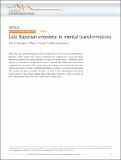| dc.contributor.author | Remington, Evan D | |
| dc.contributor.author | Parks, Tiffany V | |
| dc.contributor.author | Jazayeri, Mehrdad | |
| dc.date.accessioned | 2019-03-19T11:28:50Z | |
| dc.date.available | 2019-03-19T11:28:50Z | |
| dc.date.issued | 2018-10 | |
| dc.identifier.issn | 2041-1723 | |
| dc.identifier.uri | http://hdl.handle.net/1721.1/121034 | |
| dc.description.abstract | Many skills rely on performing noisy mental computations on noisy sensory measurements. Bayesian models suggest that humans compensate for measurement noise and reduce behavioral variability by biasing perception toward prior expectations. Whether a similar strategy is employed to compensate for noise in downstream mental and sensorimotor computations is not known. We tested humans in a battery of tasks and found that tasks which involved more complex mental transformations resulted in increased bias, suggesting that humans are able to mitigate the effect of noise in both sensorimotor and mental transformations. These results indicate that humans delay inference in order to account for both measurement noise and noise in downstream computations. | en_US |
| dc.description.sponsorship | Alfred P. Sloan Foundation (BR-2014-102) | en_US |
| dc.description.sponsorship | Esther A. and Joseph Klingenstein Fund | en_US |
| dc.description.sponsorship | Simons Foundation (542993SPI) | en_US |
| dc.description.sponsorship | McKnight Endowment Fund for Neuroscience | en_US |
| dc.description.sponsorship | McGovern Institute for Brain Research at MIT | en_US |
| dc.publisher | Nature Publishing Group | en_US |
| dc.relation.isversionof | http://dx.doi.org/10.1038/s41467-018-06726-9 | en_US |
| dc.rights | Creative Commons Attribution 4.0 International license | en_US |
| dc.rights.uri | https://creativecommons.org/licenses/by/4.0/ | en_US |
| dc.source | Nature | en_US |
| dc.title | Late Bayesian inference in mental transformations | en_US |
| dc.type | Article | en_US |
| dc.identifier.citation | Remington, Evan D., Tiffany V. Parks, and Mehrdad Jazayeri. “Late Bayesian Inference in Mental Transformations.” Nature Communications 9, no. 1 (October 24, 2018). | en_US |
| dc.contributor.department | Massachusetts Institute of Technology. Department of Brain and Cognitive Sciences | en_US |
| dc.contributor.department | McGovern Institute for Brain Research at MIT | en_US |
| dc.contributor.mitauthor | Remington, Evan D | |
| dc.contributor.mitauthor | Parks, Tiffany V | |
| dc.contributor.mitauthor | Jazayeri, Mehrdad | |
| dc.relation.journal | Nature Communications | en_US |
| dc.eprint.version | Final published version | en_US |
| dc.type.uri | http://purl.org/eprint/type/JournalArticle | en_US |
| eprint.status | http://purl.org/eprint/status/PeerReviewed | en_US |
| dc.date.updated | 2019-03-04T14:37:16Z | |
| dspace.orderedauthors | Remington, Evan D.; Parks, Tiffany V.; Jazayeri, Mehrdad | en_US |
| dspace.embargo.terms | N | en_US |
| dc.identifier.orcid | https://orcid.org/0000-0003-4431-8195 | |
| dc.identifier.orcid | https://orcid.org/0000-0001-6052-6213 | |
| mit.license | PUBLISHER_CC | en_US |
